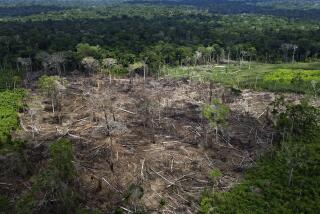Vietnam Facing New Battle: Keeping Its Forests : War, Agriculture, Abuse Could Destroy All of Nation’s Trees Within 15 Years
- Share via
HANOI — Ravaged by war, agriculture and public abuse, Vietnam’s forests are disappearing at such an alarming rate that experts say the nation could be treeless within 15 years.
Between 1943 and 1982, almost half of Vietnam’s total forest cover--17.3 million acres--vanished, leaving less than one-quarter of the southeast Asian country with significant forest land, conservationists report.
Chemical defoliants sprayed by U.S. forces during the Vietnam War are partly responsible for the massive forest losses, as are destructive agricultural techniques and the use of wood to heat and house a rapidly growing population, environmentalists say.
The Vietnamese government has launched reforestation programs, but they seem to be part of the losing battle to recover from generations of war and neglect.
Planting Troubles
Although 300,000 acres of trees are planted annually, 40% never take root, the result of poor soil, storms, fires or theft, according to the United Nations Food and Agriculture Organization.
“Actually, about 500,000 acres of planted and surviving trees are needed every year to maintain the forest industry, preserve wildlife and control floods,” an organization official in Hanoi said. “But the area that needs to be replanted the most is exactly where Agent Orange was sprayed,”
Agent Orange, a toxic component of defoliants, was used along the 17th Parallel, which once divided North Vietnam and South Vietnam before the nation was reunited in 1975.
According to U.S. statistics, American forces dropped more than 19 million gallons of herbicides on 4.9 million acres between 1964 and 1972, along with millions of tons of bombs and napalm.
Unprecedented Use
The spraying, intended to deprive the Viet Cong of shelter and concealment, was used “on a scale never before seen in the history of warfare,” according to a report from a Swiss-based conservation group.
Now, more than a decade after the end of the war, environmentalists say that huge areas still cannot sustain tree growth because of the toxic residue.
They say that wildlife has not returned, fishery catches are reduced, agricultural output is low and there is a greater chance of toxin-related diseases and cancer in and around the heavily sprayed areas.
“Not more than 20% of the sprayed forests can be recovered now,” Dr. Vo Quy, director of Vietnam’s Committee on Environmental Protection and Resources, said.
Population Boom
Vietnam’s postwar population boom also has strained the nation’s forests.
Trees, especially in the north, have been cleared for rice-growing areas.
In the central highlands, hill tribes survive on wasteful slash-and-burn agricultural techniques. They also indulge in abusive logging, the result, Vietnamese officials say, of inflated prices for forest product.
The loss of nearly half of Vietnam’s forests will have serious ramifications, states a recently published report by the Vietnam Forest Inventory and Planning Institute.
Soil Washed Away
“In these forests many products (rattan, medicinal plants and resins) and valuable animals are concentrated,” the report said. “When the rich forests disappear, these valuables also become rare.”
Experts say that about 72 tons of soil per acre are washed away annually due to the tree loss. This has led to the denuding of millions of acres of land, the report states.
“The loss of arable land due to erosion is very serious,” the report said.
“Unless this pattern of use is changed, the forest (in Vietnam) will almost disappear by the year 2,000,” reported a 1985 survey by the International Union for Conservation of Nature and Natural Resources, based in Gland, Switzerland.
Reforestation Programs
Although the Vietnamese and Swiss reports agree on the nature of the problem, the Vietnamese prognosis is more optimistic.
“It was very hard to educate people about indiscriminate cutting,” Vo said. “Now it is easier. They see the relation to erosion and flooding and how the soil runoff buries the seafood beds along the coast.”
Hanoi has three nationwide reforestation programs, which deal with permanent settlement and cultivation, land and forest distribution and agriculture.
More to Read
Sign up for Essential California
The most important California stories and recommendations in your inbox every morning.
You may occasionally receive promotional content from the Los Angeles Times.










